If you’re new to the Rickenbacker world you could be forgiven for thinking that the story of Rickenbacker pickups starts with the Toaster and ends with the Higain. And it is true that those two pickups are the heart and soul of the Rickenbacker sound and story. But friend, that’s just scratching the surface. There’s so much more to the story than those two pickups. So let’s just dive right into it!

Any discussion of Rickenbacker pickups—of ANY pickups—has to start with the horseshoe pickup, the FIRST electric guitar pickup. And that story (and indeed, Rickenbacker’s story) began in the mid 1920s when guitarist George Beauchamp began trying to figure out how to make his acoustic Hawaiian guitar louder to allow it to cut through the rest of his band.
Beauchamp first approached violinist and luthier John Dopyera for assistance. After several attempts, Dopyera—with the assistance of one Paul Barth—came up with the design for what would become the resonator guitar. Dopyera and Beauchamp would then found the National String Instrument Corp. to build these resonator guitars. And as the company grew, they outsourced the metal body manufacturing to a nearby metal fabrication firm run by one Adolph Rickenbacher.

The rise and fall and eventual merger of National and Dobro Guitars—which Dopyera would found in 1928 after leaving National in a huff—is a long and complicated story with plenty of intrigue and infighting. For our purposes it’s enough to know that by the early 1930s Beauchamp was out at National, but had never given up on still more loud.
Experiments with microphones and phonograph needles had been unsuccessful, but they led him to night classes in electronics where he learned about electromagnetic fields and how movement inside that field changes the electrical current in the wire that created it. That concept gave him the idea that would become—with Paul Barth’s assistance and a lot of trial and error—the very first electromagnetic guitar pickup: the horseshoe pickup.
Needing a financial backer, in 1931 he and Barth formed a new company with Adolph Rickenbacher—the Ro-Pat-In company, which would become the precursor of today’s Rickenbacker International Corporation—to produce electrically amplified stringed instruments. And, in 1932, the Rickenbacher Electro Model A22 “frying pan” became the world’s first commercially available electric (albeit Hawaiian/lap steel) guitar.
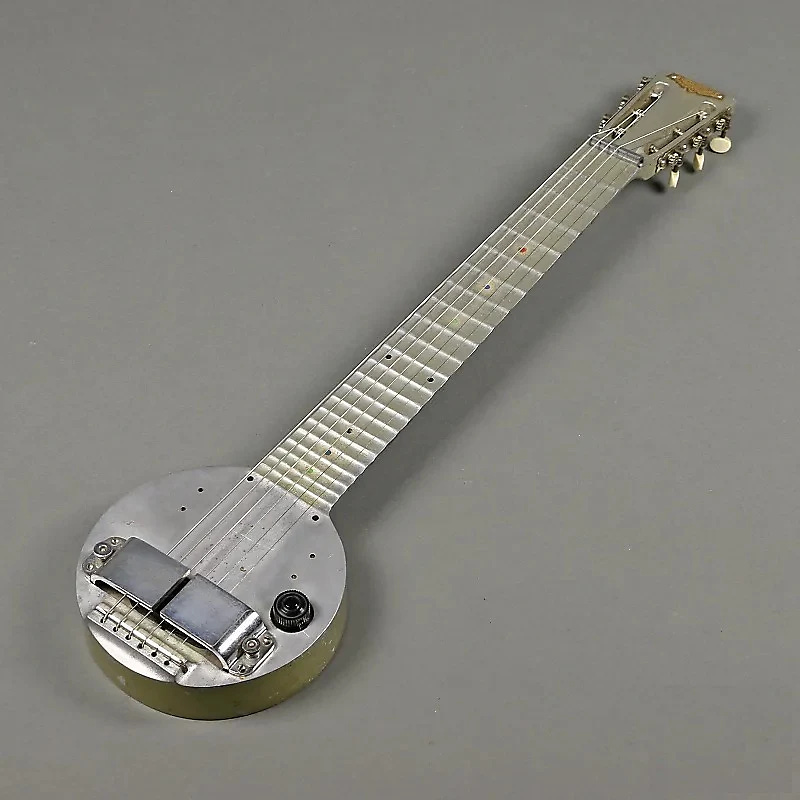
The anatomy of that first pickup was quite different from today’s pickups. I mean it has the same basic components—magnet, polepieces, wire—but they’re assembled differently. It was the first draft, after all. So unlike modern pickups where the magnet is inside the pickup, in the horseshoe pickup the pickup is inside the magnet.

Let’s try and make that a little clearer. We’ll use toaster and Higain pickups as examples to explain that difference. A toaster has 6 magnetic polepieces held in a bobbin which is then wound with wire. That’s it. Complete pickup. A Higain has 6 non magnetic polepieces held in a bobbin which is wound with wire, and a magnet is then placed at the bottom of that assembly magnetizing the polepieces. Complete pickup.
But the horseshoe is different. It starts off the same as the Higain—6 nonmagnetic polepieces held in a bobbin which is wound with wire, but then that entire assembly is surrounded by two—wait for it—horseshoe shaped cobalt magnets, magnetizing the polepieces. The strings then pass between the top of the bobbin and the underside of the horseshoe magnets—a much wider magnetic field.
Rickenbacker would spend the 1930s slapping variants of that basic pickup design onto instruments under the “Electro” name that ranged from Hawaiian guitars to violins to upright basses.

They even produced much more traditional “Spanish” style guitars with the horseshoe pickup—adding their electronics to guitar bodies bought from Harmony.
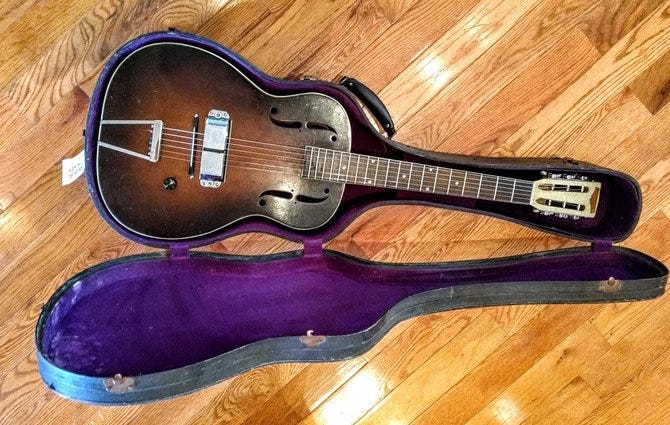
But as we all know, while it was a great fit for lap steels the horseshoe just wasn’t when it came to a Spanish guitar application—those big bulky magnets were just in the player’s way. So while everyone in the industry saw the promise of the electric guitar, all the other manufacturers went to work developing their own, less bulky pickups, leaving Rickenbacker’s Spanish guitars in the dust.
So Rickenbacker focused on what worked best for them and their pickup: lap steels. Which was fine, until the early 1950s when the demand for electric Spanish guitars exploded.
Beauchamp had sold his share of the business in 1940, and Rickenbacker did the same in 1953 when he sold the entire company to F.C. Hall. Hall had been Leo Fender’s US distributor since 1946, and recognized the potential value of controlling both the manufacturing and distribution of musical instruments and amplifiers. And to really capitalize on that opportunity he needed Spanish guitars.
So a design was sourced from an outside firm—and refined by a new hire by the name of Roger Rossmeisl—and launched in 1954 as the Combo 600 and Combo 800…with the current version of the tried and true horseshoe pickup.

Well, that’s true for the Combo 600. The Combo 800 had something new hiding under those horseshoe magnets: the “Rickenbacker Multiple-Unit”, the first commercially available humbucking pickup.
While the idea for a humbucker pickup had appeared shortly after the A22 had launched, and the idea had been subsequently refined, it had been for other applications like microphones and pianos. And so it still hadn’t made it to the guitar world or a production guitar by 1954 when the Combo 800 launched.

Not only was it the first commercially available humbucking guitar pickup, it was the first “coil splittable” humbucking pickup as each coil could be individually turned on or off. One could therefore argue that technically it’s two separate pickups, with the polarity reversed on one to provide the humbucking effect when both were selected. But we’re going to call it the first humbucker anyway. While a patent was never filed, if they had they would have beaten both Gibson and Gretsch. Screw you, Seth Lover!
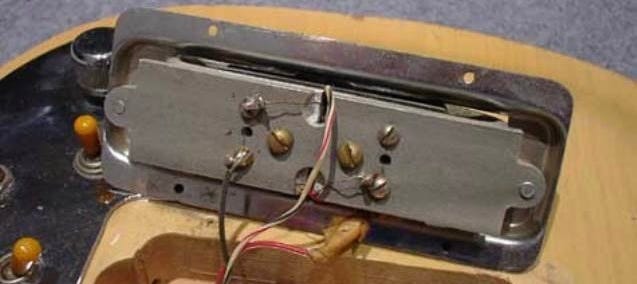
The horseshoe’s days as a guitar pickup were numbered, though. It was used on the Combo 600 and 800 because it was “what they had”, but a player comfort was still an issue and a replacement was sorely needed. While the two pickup 850 launched in 1957 would continue to utilize the horseshoe in the bridge position, it would be the last new model to feature the pickup. With the introduction of the toaster pickup in the neck position of the Combo 850 in 1957, 1958 would see the last horseshoe-equipped guitars leave the factory as the old Combo 600, 800, and 850 models were discontinued.
But don’t count out the horseshoe just yet, because it got a new lease on life in 1957 with the launch of the 4000 bass.

The SOUND of the horseshoe had never been the problem. In fact, it is still regarded today as one of the if not the best sounding lap steel pickups ever. It was its impact on playability that had doomed it as a guitar pickup. But with the way basses were played in those early days, that was much less of an issue. A slight modification from six polepieces to four meant Rickenbacker had a great sounding pickup ready to go as they entered the electric bass guitar market.

When the Deluxe two pickup 4001 joined the line in 1961, it gained a toaster in the neck position but kept the horseshoe at the bridge. And so it would until late 1968 when the new Higain pickup finally ended the horseshoe’s 37 year run. But by that point the “look” of the horseshoe was so integral to the 4001’s design that the Higain retained the horseshoe’s mounting ring and got a function-less cover to mimic the horseshoe’s look. That look lasted on most Rickenbacker basses until early 2025 when the purely decorative cover—which many folks remove—was finally eliminated.

The horseshoe has a postscript. When the first semi-accurate reproduction of Paul McCartney’s 1964 4001S, the 4001V63, was introduced in 1984, a Higain-based cosmetic reproduction of the horseshoe that featured non magnetic “horseshoes” was designed for it. Because Rickenbacker never throws anything away, it is said that a handful of the very first guitars built were equipped with original horseshoes left over from 1968!
I realize we spent a lot of time on the horseshoe, and that makes sense given how important that pickup is to both Rickenbacker and electric guitar history writ large. I promise we won’t have as much to say about the other pickups on this list. Let’s move on!
The next “other”’pickup in Rickenbacker’s history is actually the second pickup in Rickenbacker history, and the only one not developed in house. When the tulip-shaped neck-through Combo 400 was being developed they knew they needed a solution other than the horseshoe, but that was the only pickup in their cupboard. And so when the Combo 400 launched in 1956 it came with an off-the-shelf DeArmond pickup produced by Rowe Industries.
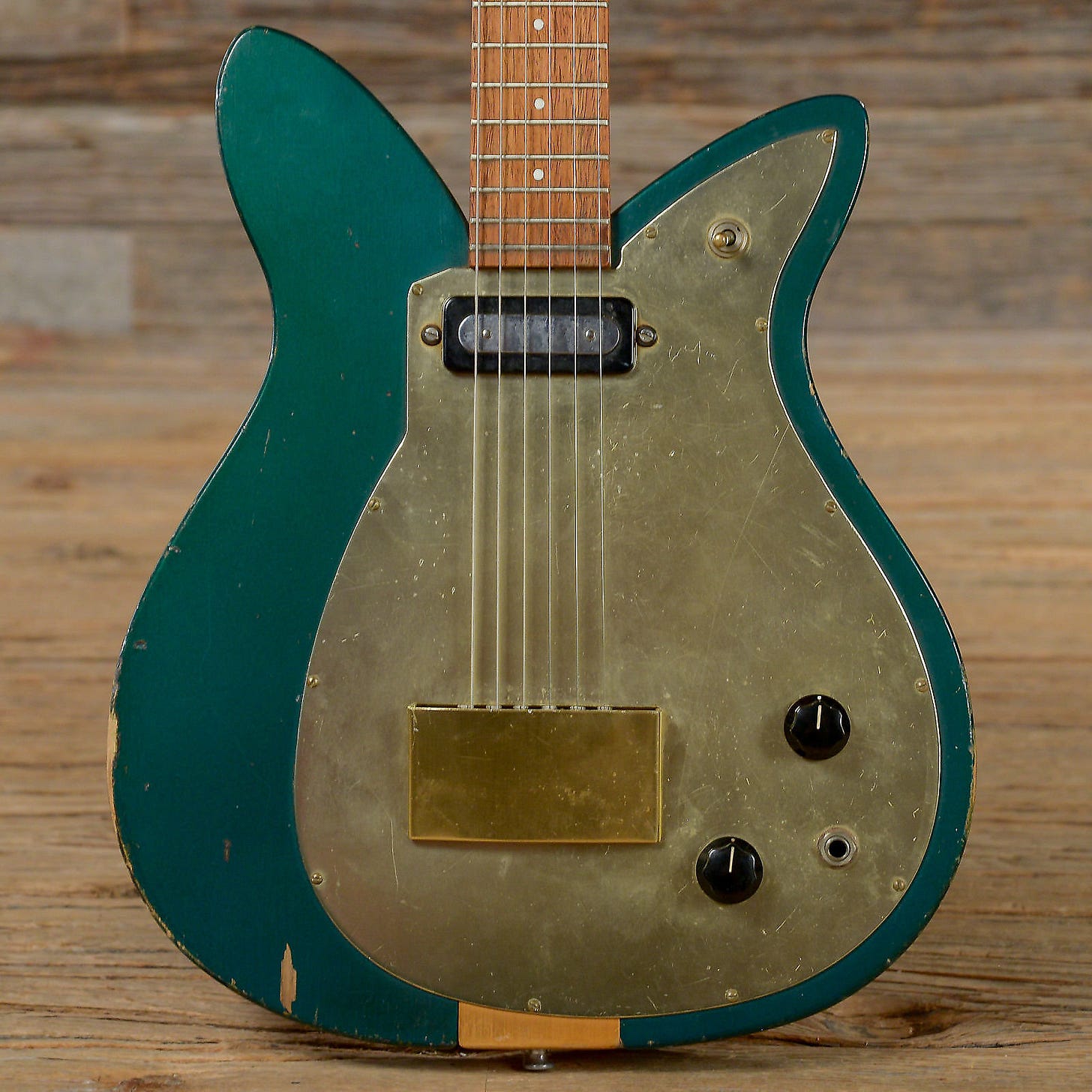
A long time supplier and partner, DeArmond pickups and accessories already had their own category in period Rickenbacker catalogs and price lists. Selecting a DeArmond pickup for the Combo 400 was therefore a logical choice.

DeArmond made a wide variety of pickups used by guitar manufacturers like Guild, Epiphone, Martin and Gretsch. Many are quite famous and sought after today, like the Model 2000 Dynasonic. The pickup Rickenbacker selected, however, was a relatively simple and no-frills unit whose only other “notable” fitment was on the Epiphone Harry Volpe Signature model.

Prototype/early production examples from early to mid 1957 of the short scale student models 900, 950, and 1000 as well as the new two pickup version of the Combo 400, the Combo 450, featured the DeArmond pickup. By the end of the year, however, all Rickenbacker models featured the new toaster pickup.
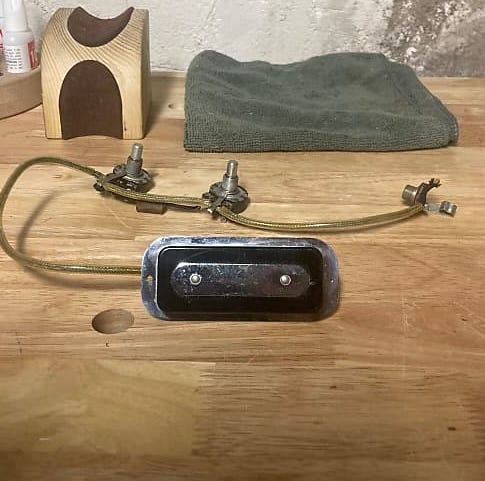

The Epiphone Harry Volpe model didn’t last much longer than the Combo 400. As these were the only significant fitments for these pickups and their production runs were so short, finding replacements today is extremely difficult and expensive. While the horseshoe pickup was clearly an important and lasting milestone in the company’s history, the DeArmond pickup was a stopgap measure that bought Rickenbacker the time they needed to develop their own signature pickup.
I’m only going to briefly mention the next “other” pickup as a) it’s really just a variation of the toaster pickup, and b) I have to assume it exists because I can find no photographic proof. According to Martin Kelly’s excellent book, Rickenbacker Guitars: Out of the Frying Pan and Into the Fireglo “Rossmeisl built the first 4001 in November 1961 adding a newly designed toaster pickup with 4 pole pieces near the neck.”
By the time the 4001 reached “production status” in 1963 it had a standard 6 polepiece toaster at the neck—as have all subsequent toaster-equipped basses. But Kelly usually knows what he’s talking about, so we’re going to assume he’s right.

And yes, there have been multiple changes to the toaster—and the Higain!—over the years, but we’re not going to discuss those here. Those pickups are important enough to get their own overviews, and we’ll cover them there. But this just seemed worthy of calling out. You can read all about the Higain’s evolution here. The toaster story will follow soon!
The toaster reigned supreme for a long time as the only Rickenbacker pickup on the block. If it ain’t broke, don’t fix it! But the market’s tastes changed over time, and eventually the toaster was forced to hand its crown to the Higain. But when even that didn’t seem to meet the market’s demand, it was time for the first new pickup in a while: Rickenbacker’s first “true” humbucker.
The pickup actually came before the guitar it officially debuted on. And we need to put this in context. Rickenbacker guitar sales had cratered in the late 1960s/early 1970s. The look, the sound…they just seemed so dated. Nobody was buying. Basses were about to explode—which saved Rickenbacker in the 1970s—but they hadn’t yet. So the company was trying to figure out how to remain relevant. They gave the market “hotter” pickups—thus the “Higain” name. They increased the number of frets from 21 to 24. They made guitars with slanted frets. Heck, they even made a guitar with Christmas lights inside that changed colors based on what you were playing! None of it worked.
Around this time, a few years after the 1965 sale to CBS, longtime Fender factory manager Forrest White left the company after disagreements with the new management. He eventually landed at Rickenbacker, and brought some new guitar designs with him. One in particular was a double cutaway Telecaster-ish guitar with a bolt-on neck that would be go on to be used twice over the years: first as the 430 in 1975, and then again on the 200 series guitars launched in 1985.
But there were multiple prototypes based on that body before then: first in 1971 as the (different than the 1975 production version) 430 and 470, and then again in 1973 as the 490.
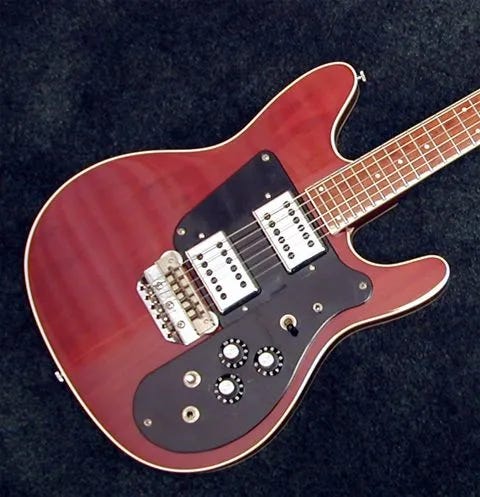
While the 1971 430 and 470 were basically Telecaster clones, as proposed the 490 had an interesting party trick: interchangeable electronics modules. The documentation that exists mentions a “Tele-ish” module, an active electronics module, and—as seen above on the prototype—a double humbucker module. Remember these pickups! These are them!
Now, in order to capitalize on the 4001’s sudden popularity Rickenbacker had introduced the 4001-shaped 480 guitar in 1972. And that did..okay. But given that it was built out of off-the-shelf Rickenbacker parts it still didn’t have that “heavier” sound the market wanted. Maybe it would do better if it could do that?
So…we have a popular body shape that doesn’t quite meet the market demand, and a brand new humbucking pickup design that doesn’t have a home. Why not put them together? Enter the 481 in 1974.

For their first year they got the black textured plastic covers seen above, with only one set of polepieces visible. Here’s a clearer shot:

In 1975, they got a chrome plated plastic cover with both sets of adjustable polepieces visible.

And starting in late 1976 those covers got a debossed “Rickenbacker” logo in the center.
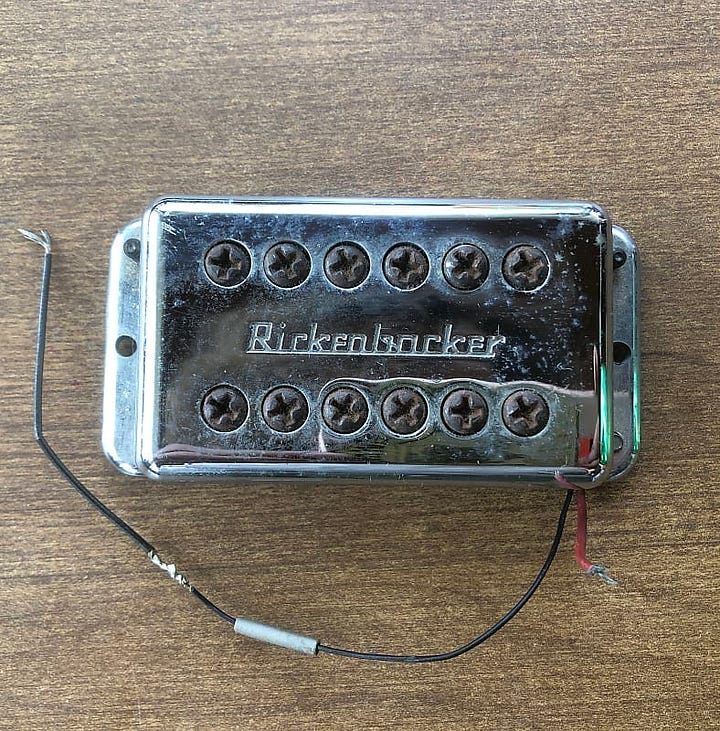
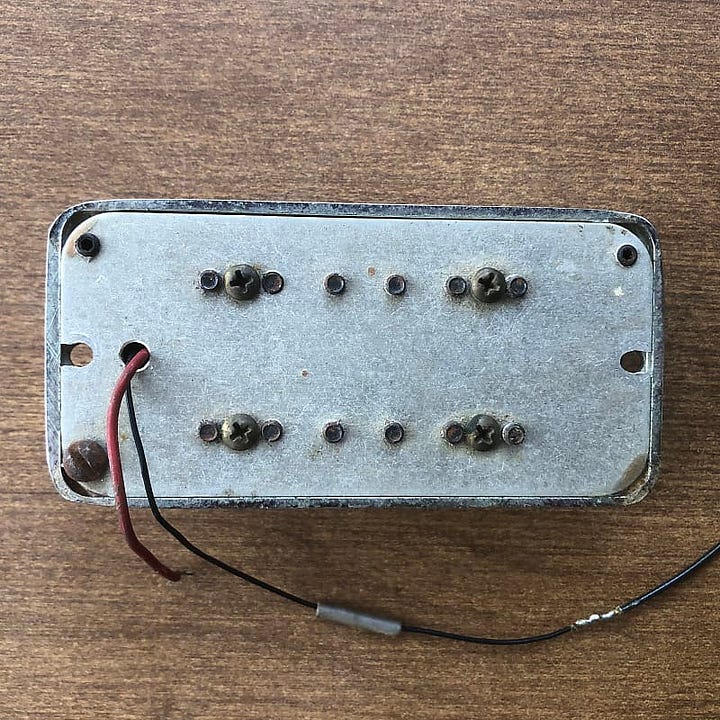
If those pickups look big to you, that’s because they are! Replace them with standard Gibson-type humbuckers and there’s a pretty good-sized gap left where the originals had been.
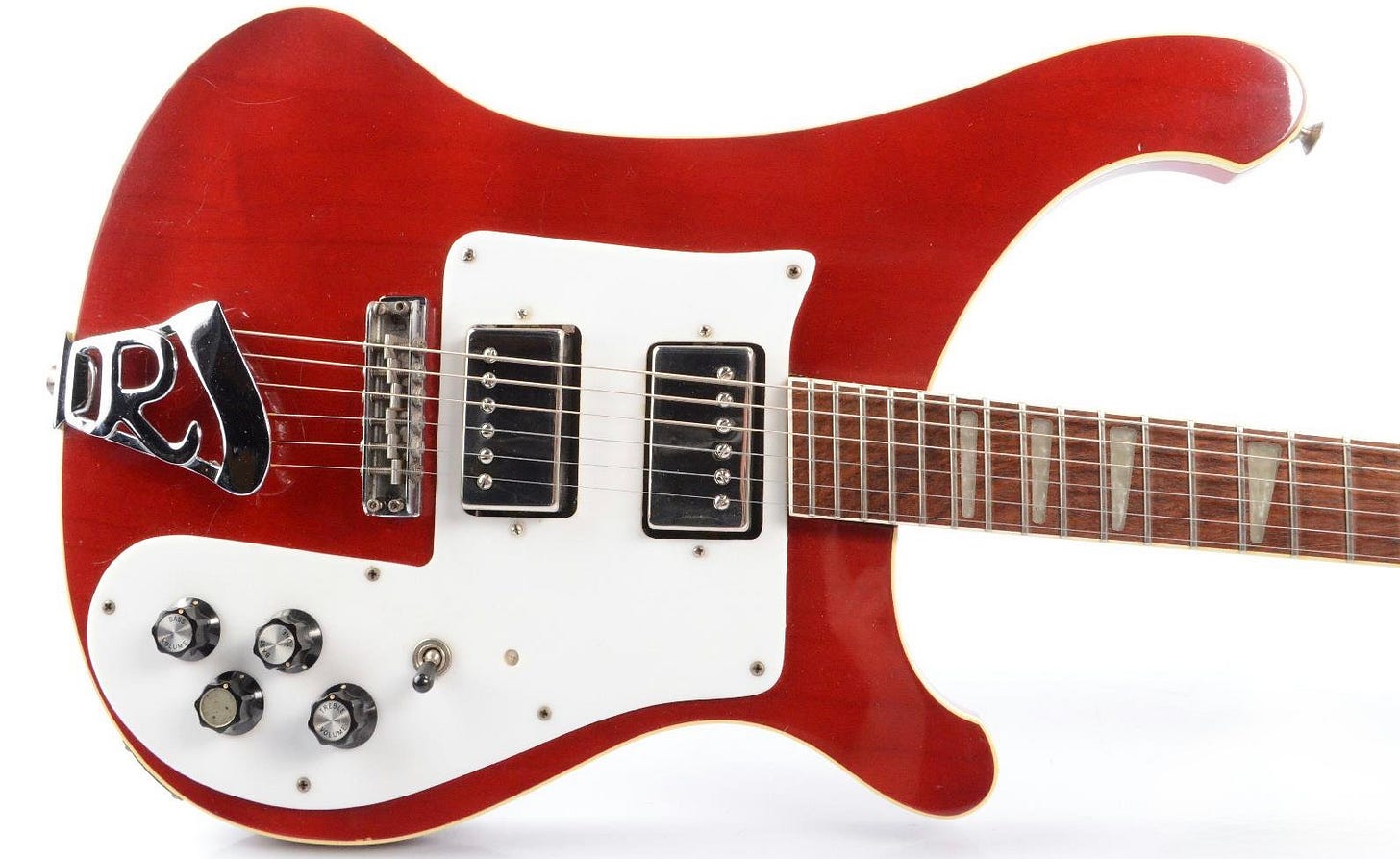
And no, there’s nothing wrong with this picture apart from the replaced pickups. Remember the “desperate measures” slanted frets mentioned earlier? While they didn’t really catch on, for some reason Rickenbacker chose to fit them as standard on the 481—although normal frets were an option.
The other unusual thing you probably noticed is the polepieces. Ever see Philips head polepieces before? Yes, others exist, but it’s as uncommon as you think it is. And the others are not that big. Between the size and the polepieces…well, you won’t mistake them for anything else. The 481 ended production in 1982, and so did its humbucking pickup.
But wait! There was another new Forrest White-designed guitar with a a new pickup in 1974! Two guitars, in fact: the 3000 and 3001 basses.

The 3000 and 3001 were designed to compete with Fender with the “premium” Rickenbacker brand at a price about two thirds the cost of the 4001. The 3000 and 3001 featured standard appointments, bolt on neck construction, and a new single coil “ultra high gain, noise cancelling” pickup. Ok? The single coil pickup’s output was about 8.5k ohm, and it was encased in epoxy to reduce electronic interference.

The black plastic case had two “ears” to allow it to be attached to the pickguard.
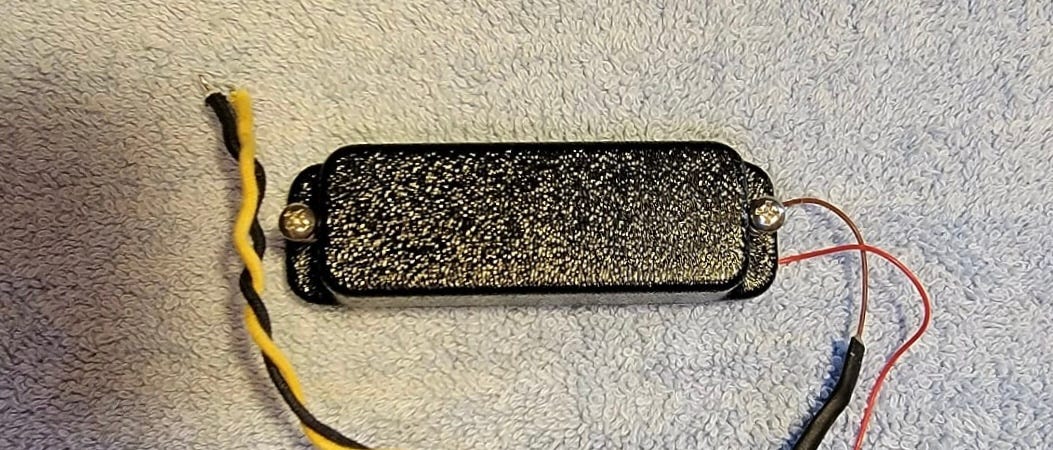
At some point in any discussion of the 3000 and 3001 somebody will say it sounds like “a P-bass on steroids”. That’s as good a description as any! But given that these guitars launched at about the same time 4001 demand exploded, the financial “need” for the model disappeared and production capacity was directed towards the more profitable 4001. A lack of promotion and a compelling story led to production ending in 1979 for the 3001 and 1980 for the 3000. But the pickup would be back!
Here’s an “other” Rickenbacker pickup that ISN’T an “other” Rickenbacker pickup: the pickups found on the 430, produced in 1975 and 1976.

If this looks to you like a Higain with a black plastic case, that’s because…it’s a Higain with a black plastic case. Next!
Let us now turn to one of the most complex and interesting “other” Rickenbacker pickups: the Super High Gain Humbucker found on the 4002 bass. Although if we’re being technical the neck and the bridge pickup have a significant difference, so there are actually TWO Super High Gain Humbuckers. But first let’s learn a bit about the 4002.

Launched in 1977, the 4002 was the Cadillac of the 4000 series of basses. It featured birdseye/flamed maple body wings, checkered front binding, a bound headstock, and a black bound ebony fingerboard.
It was not a “custom” or “special order” guitar. It was on the price list and anyone could order one. But at an MSRP of $1,275 (about $6,700 in today’s dollars) when a 4001 was $588 (about $3,100), not many people did. That’s why they are (I’m so sorry for what I’m about to say) as rare as hens teeth today.
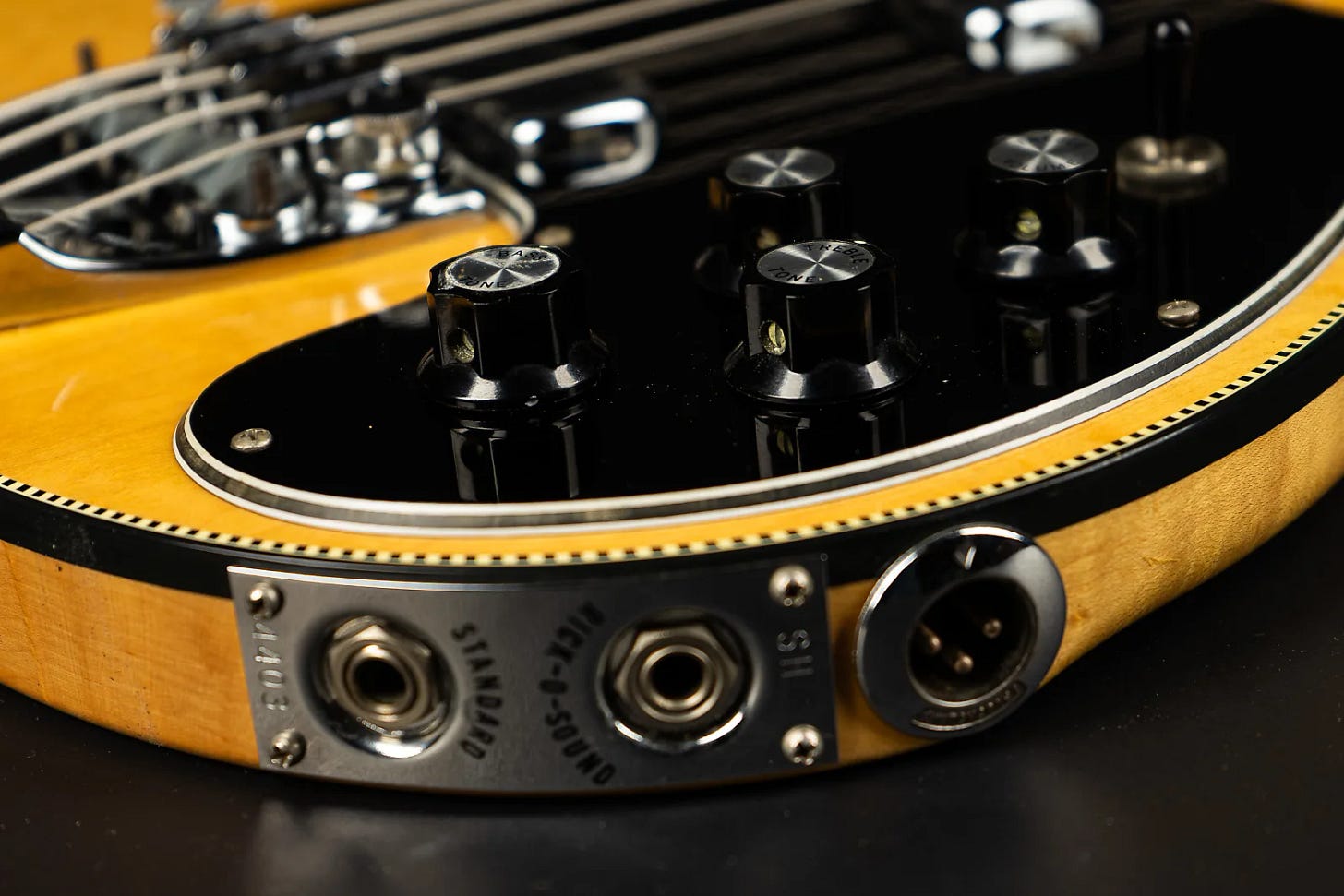
While the appointments listed above were certainly nice, the real selling point of the 4002 was the electronics, as the XLR output jack above hints towards.
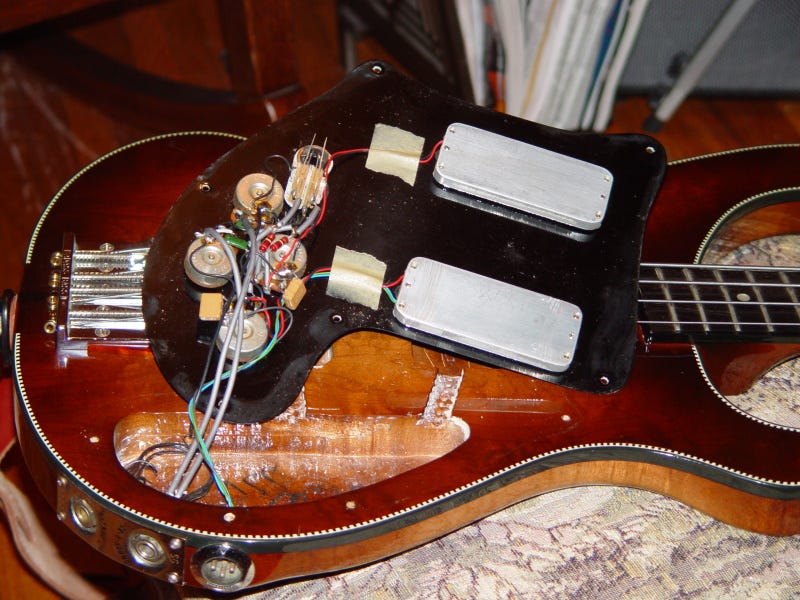
So while our focus here is obviously pickups, I want you to note the wiring harness. A “standard” 4001 harness has 3 capacitors in the circuit. I count 6 here. There’s a lot going on in that circuit!
And you’ll also notice the sealed pickups. So let’s talk about what’s going on inside! When I say “humbuckers” you immediately picture something like a Gibson PAF, right? Effectively two pickups pressed right up against each other side by side. Or maybe, if you think outside the box, you picture something like a Gibson P-100 or a Fender “Noiseless” pickup with the two coils stacked right on top of each other within the normal footprint of their single coil brethren.
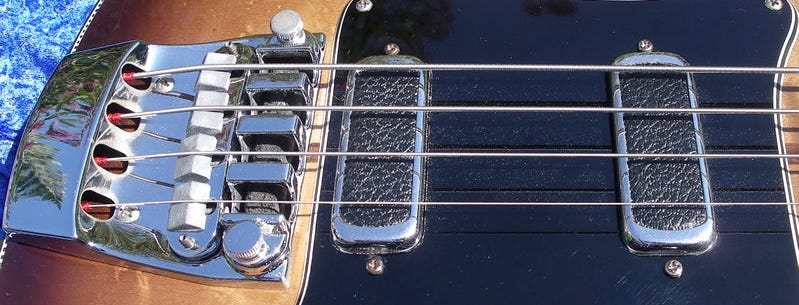
That’s not what’s happening here. Instead, stuffed inside a normal Higain case, we have two side-by-side coils—one for the E and A strings, and one for the D and G strings. Which may sound crazy until you realize that we just described a P-bass pickup—except the P-bass coils are offset slightly. The coils in the 4002 pickup are hidden beneath a layer of what appears to be a grained Tolex-like material.
But the bridge pickup has another trick up its sleeve. Let’s zoom in slightly on the wiring picture we showed above:

Notice how both pickups have a red output wire, but the bridge pickup also has a green output wire. That’s because it has two completely separate sets of windings—in technical terms it’s a “bifilar coil”. Effectively, there are two separate pickups inside the case.
This is not the same as what is commonly referred to as a “coil-tappable” pickup. In that case, a “part” of the windings can be engaged or disengaged to change the output of the pickup. This is not that. The red wire is the output for “one”pickup, and the green wire is the output for the “other” pickup.
The red wire feeds the wiring harness we see above, and the green directly feeds the XLR jack—a low impedance output that can be plugged directly into a mixing board for recording.
Sonically, the “red” pickups apparently have a much wider range than a standard Higain, although the complex harness certainly plays a significant role in that. The “green” pickup, however, is described as somewhat thin sounding.
Given the price not many 4002s were produced, and the model was discontinued in 1984 after John Hall bought the company from his father. As recently as a few years ago, however, there have been verified sightings of “leftover” body wings in the factory, and and there have been one-off 4002-inspired guitars built over the years—although without the original’s pickups.
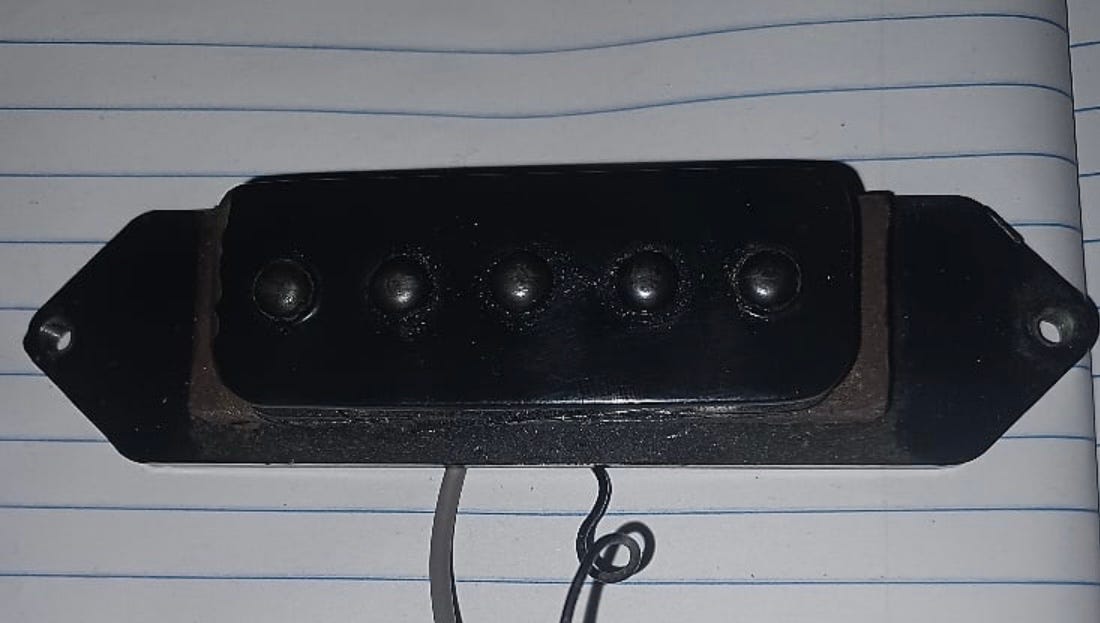
So here’s another “not really a new pickup”. When the first version of 5 string 4003S/5 appeared around 1982, it featured an otherwise standard Higain bass bridge pickup modified to have an appropriate 5 polepieces. And that’s it. That’s the only difference.
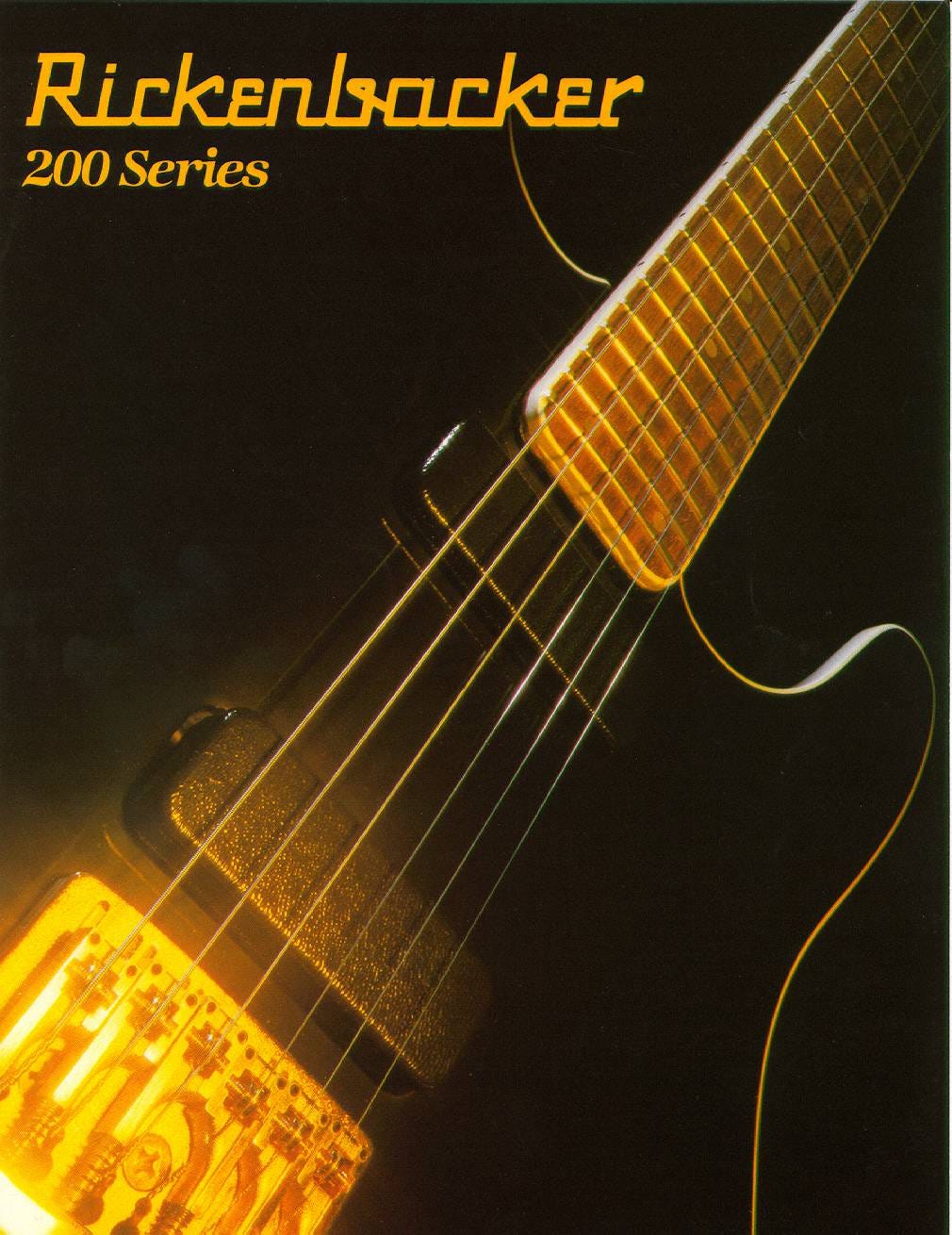
In 1984 the Forrest White designed 430 guitar and 3001 bass shapes got a new lease on life as the 200 and 2000 series of guitars and basses. And so did the 3000/3001’s pickup. Well, mostly.
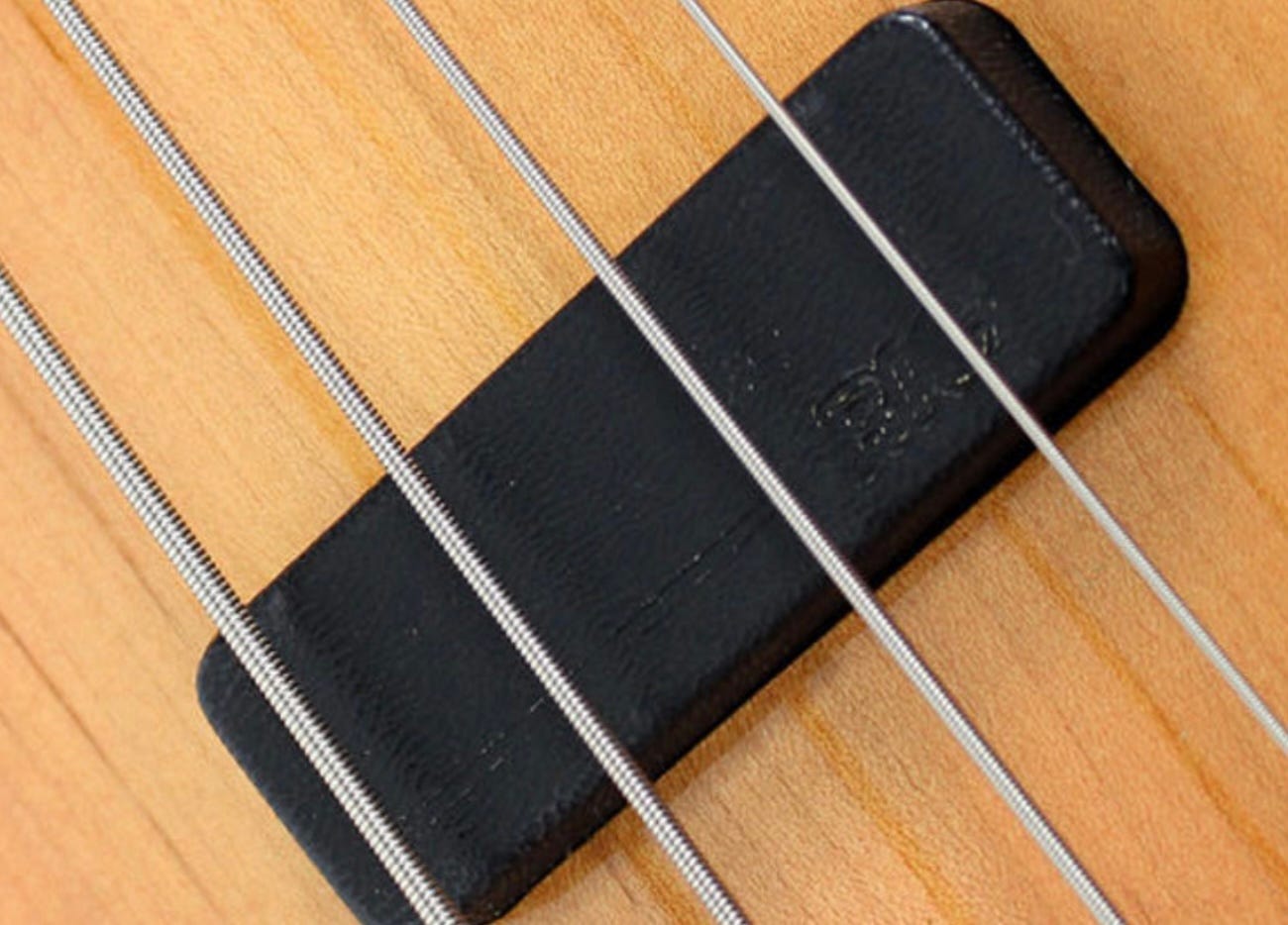
What’s missing here? Mounting screws! Where are the mounting screws, and the “ears” found on the 3000/3001’s case? How do you mount this pickup to the guitar? Well…from the rear.
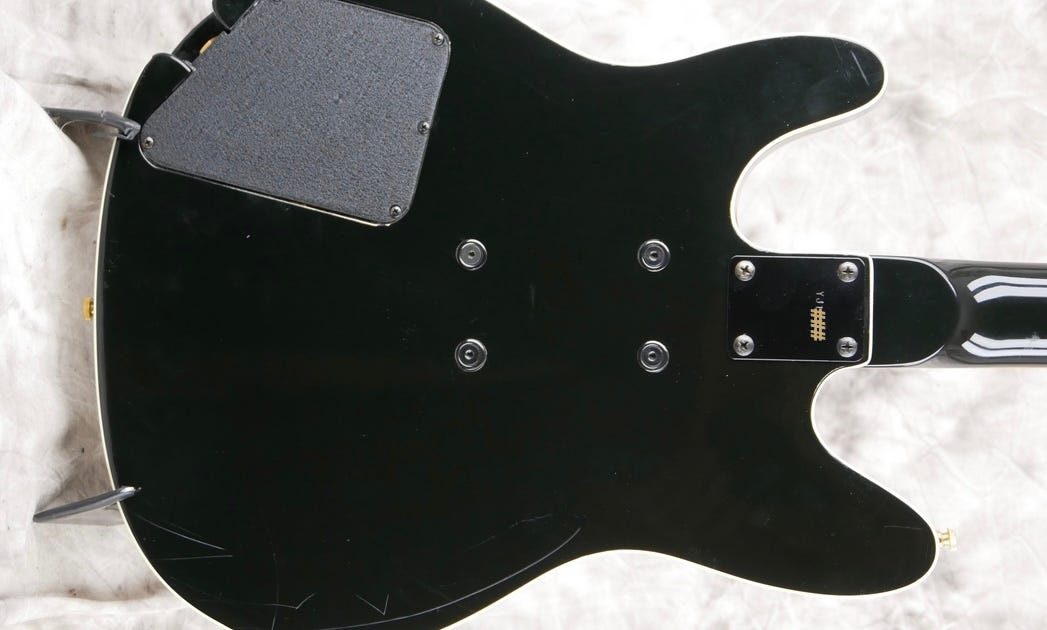
I tried—OH how I tried—to find a photo of the back of this guitar’s pickup to show you how it was installed. And here it is. The only picture on the internet of the 200/2000 pickup’s back:
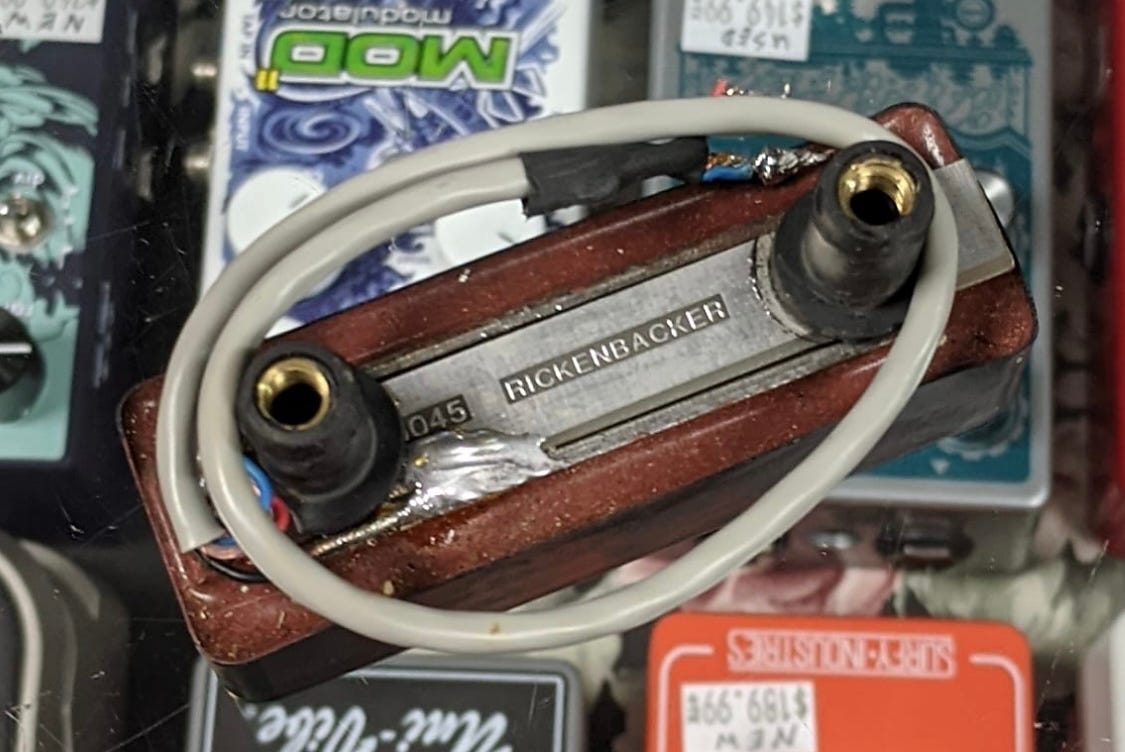
Now…this is a later version of the pickup that shares the same footprint. So just look at the mounting “legs”. We’ll talk about the guts of the new version in a minute! But the guts of the first version? Same as the 3000/3001’s pickup. Just in a slightly different wrapper.
The guts would change in 1988. But not before good old “waste not, want not” Rickenbacker had wrung a few more years of use out of the “P-bass on steroids” pickup that had debuted back in 1974. And now we move on to the modern era “other” pickups!
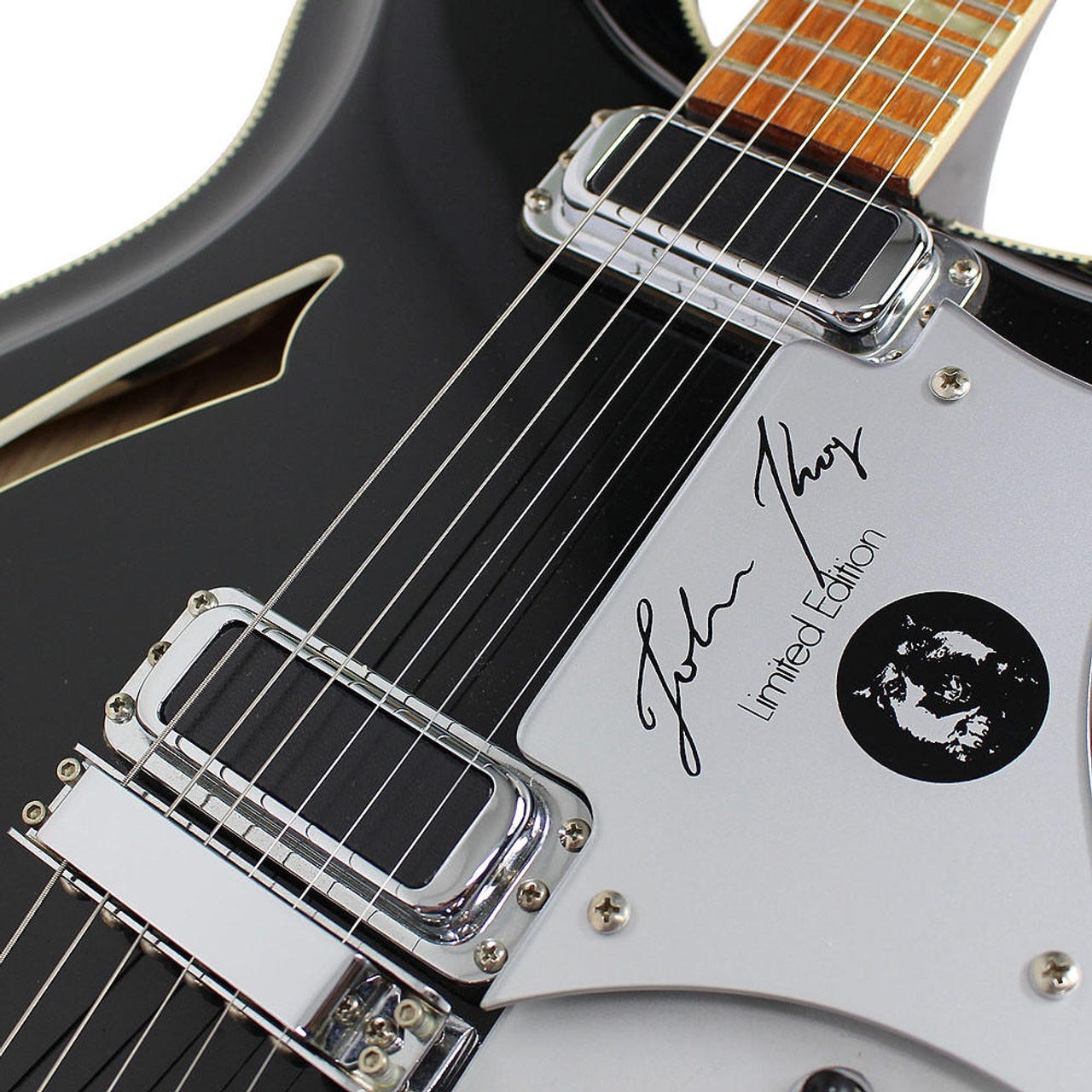
The new HB1 humbucking pickup first appeared on the 350SH and 381JK Signature Limited Edition guitars in 1989. Despite fitting neatly inside a Higain case just like the 4002’s humbucker, it was a very different animal inside.
The HB1 featured two narrow standard “side by side” bobbins, each with a single steel blade rather than individual polepieces. This allowed the pickup to be used on both basses and guitars. A bar magnet fits between the two blades on the underside of the pickup, and the entire pickup case is filled with epoxy with an exposed PCB board allowing access to all the guitars’s outputs—which provides lots of wiring options!
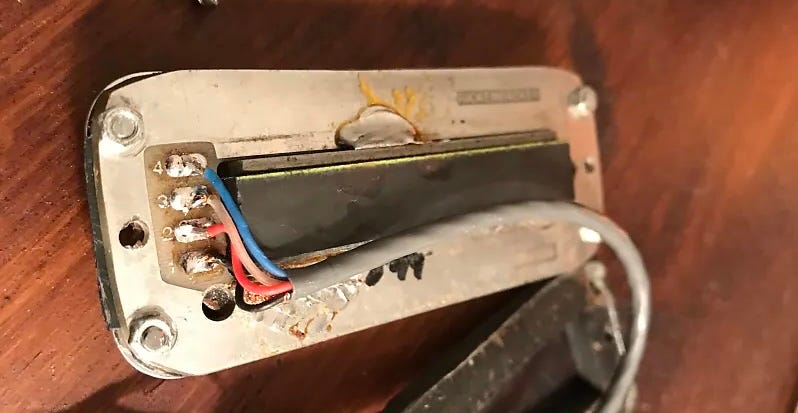
For example, on the 381JK the pickups could have their coils split, be engaged in series or parallel, be used with or without active onboard electronics, and put in or out of phase. A very versatile pickup!
It would go on to be used on the 650 series of guitars, the 380 Laguna, and the 4004 basses—including the 4004LK Lemmy Kilmister Signature Limited Edition. Although it hasn’t been used on a production model since the 4004 was discontinued in 2017 it still pops up from time to time on one-off Rickenbacker Boutique guitars and you can still buy a new one directly from Rickenbacker. So not entirely dead yet!
So if there’s an HB1 is there an HB2? Sure is! And despite its name, the HB2 humbucking pickup actually hit the shelves one year BEFORE the HB1, on the 200/2000 series guitars and basses in 1988. I told you we’d get here in a minute! So why is it called the HB2 and not the HB1 if it came first?
Because it’s literally the exact same pickup as the HB1–which was designed for the 381JK—stuffed inside the literally exact same case as the single coil pickup it replaced on the 200/2000 series guitars and basses. For its first few years of the HB2’s life you literally cannot tell if the pickup is the old single coil or the HB2 just by looking at the top of it.
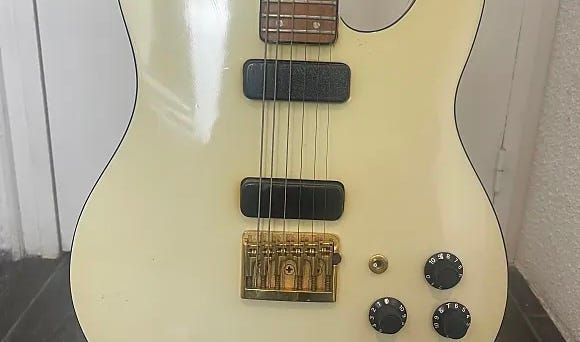
Around late 1991/early 1992 the plastic cover got a “RIC” stamp in the bottom right hand corner and a stamped line leading into and out of it. Some people say around the same time they got wound a little hotter—from around 12k ohms to 14k ohms. Some say they were always 14k (as are the HB1s). I can’t find proof either way, so any data would be appreciated!

When the 200/2000 series got a cosmetic refresh in late 1992, so did the HB2s with the imprinted “RIC” stamp and lines being filled with white paint.

1993 was the last year for the 200/2000 series of guitars and basses, except for the 230GF/2030GF Signature Limited Edition model which sporadically dribbled out until 2000. And that was the end of the HB2. If you’re hoping to find a replacement today, they’re made of unobtanium. Good luck to you!
We wrap up our discussion of “other” Rickenbacker pickups with the newest and most unusual: the 4003S/5 TriPower. I bet you’ve never heard that name before. I hadn’t either! The only place you’ll find it is on the Rickenbacker.com product page for the now-discontinued second version of the 4003S/5.
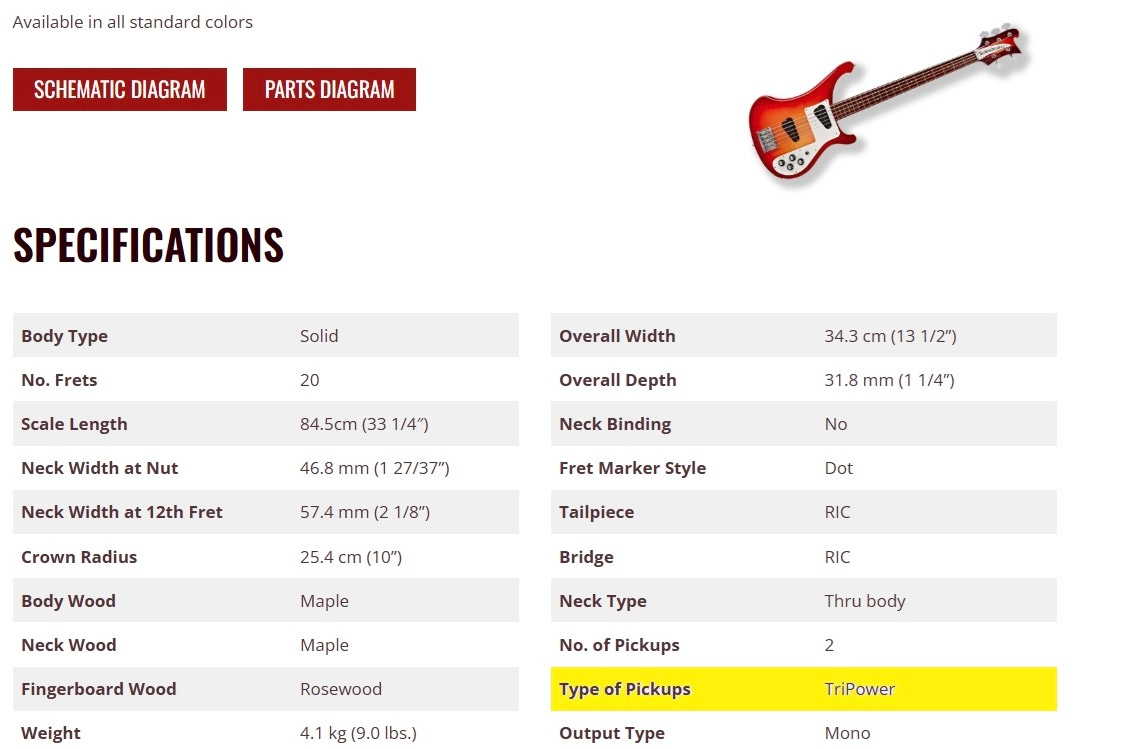
What you will find it called in many places is the “Dorito” pickup! Despite being the newest “other” pickup out there, there’s not a lot of information available out there about it. I chalk that up to two reasons. One, it was launched in 2018 in Rickenbacker’s post-press release/social media era, so there wasn’t much formal info when it was introduced. Two, the model didn’t really appeal to the “traditional” Rickenbacker fan so it hasn’t been discussed and dissected ad nauseum in the usual places.
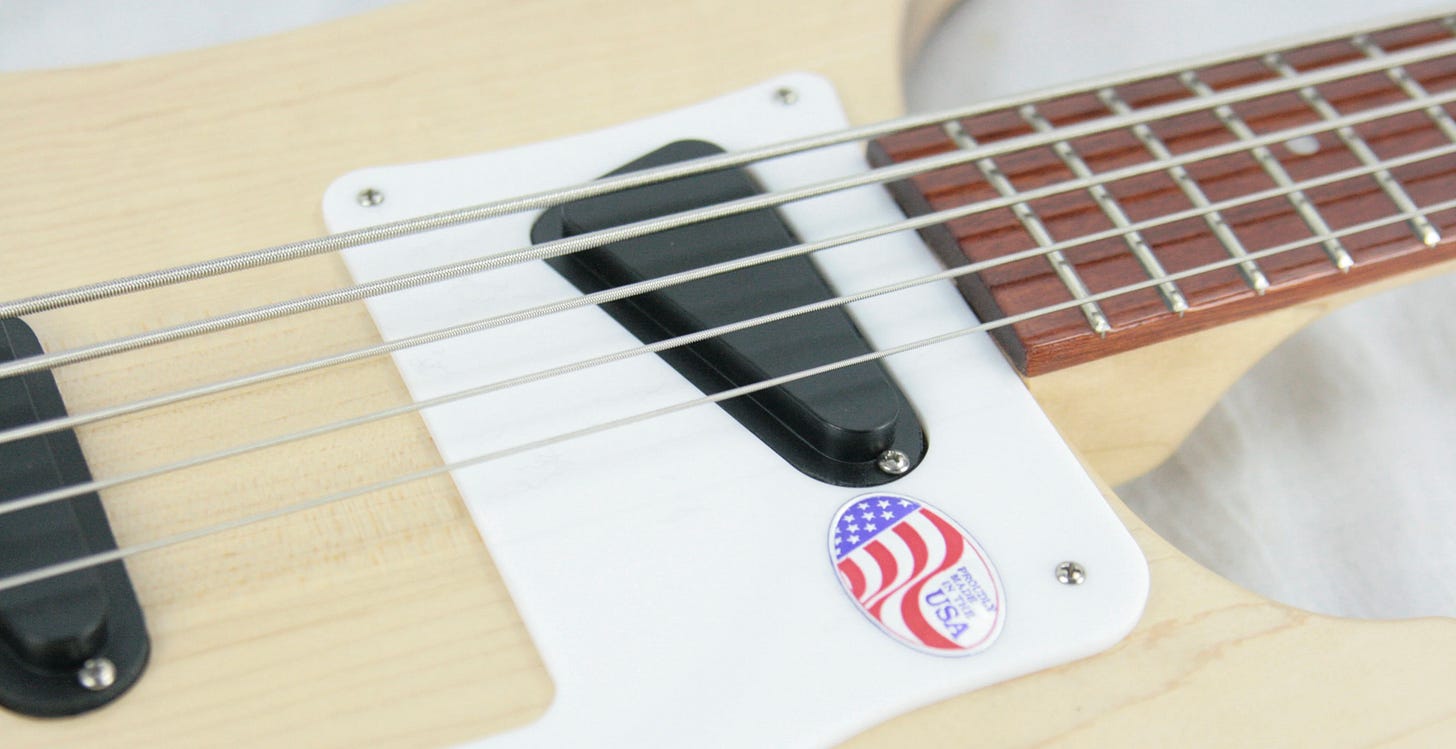
Here’s what we do know. At its heart are two bar magnets that angle outwards towards the low B string, giving it its distinctive triangular shape. Given the two magnets you might think it’s a humbucker, but it is a single coil. Here’s what it looks like with the cover off:
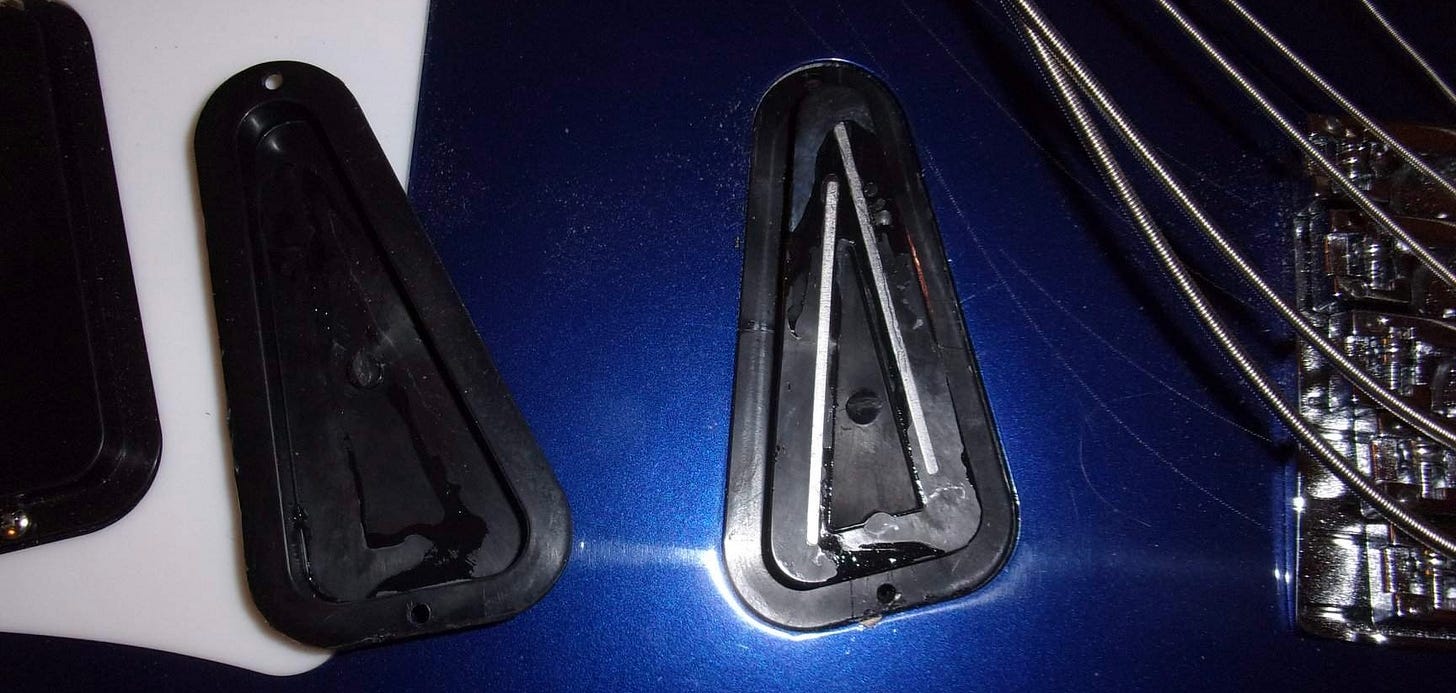
The theory behind it was that the wider magnetic field by the B-string would provide better bass response. Ok, sure.
5-string players found the guitar much more comfortable to play than the 1980s version, and liked the sound—but it did not sound like a Rickenbacker. Which may have doomed the guitar in the long run, as it was quietly discontinued in 2022.
And so so completes our tour through Rickenbacker’s “other” pickups. More than you thought, I bet! Let’s recap:
Horseshoe: 1932-1968
DeArmond: 1956-1957
Toaster: 1957-1974, 1982-present
Higain: 1968-present
481 Humbucker: 1974-1982
3000/3001, 200/2000 Series single coil: 1974-1980, 1984-1987
Super High Gain Humbucker: 1977-1984
HB2: 1988-1993
HB1: 1989-2017
TriPower: 2018-2022
Did I miss one? Let me know!


I owned a used pawnshop ‘83 4002 that had been gutted of its original electronics and pickups. I’ve always been curious about the sound of the original, but there seems to be next to zero recordings of them.
Nice work, Andy! A couple of points:
You mentioned Paul Barth was instrumental (sic) in the design of the 600 and 800 series Combos. According to Martin Kelly's book, FC Hall hired a design firm to come up with the 600 Combo design, which RIC adapted to the final design with some changes - no snakehead headstock and the body is carved out from the back rather than the front. Perhaps Paul Barth contributed to those refinements of the original design.
The other observation I have is that I've never seen a 450 Combo with two DeArmond pickups. The 450s have two of the original "toaster-top" pickups. I will stand corrected if there is an example of dual DeArmond's on a 450 out there.